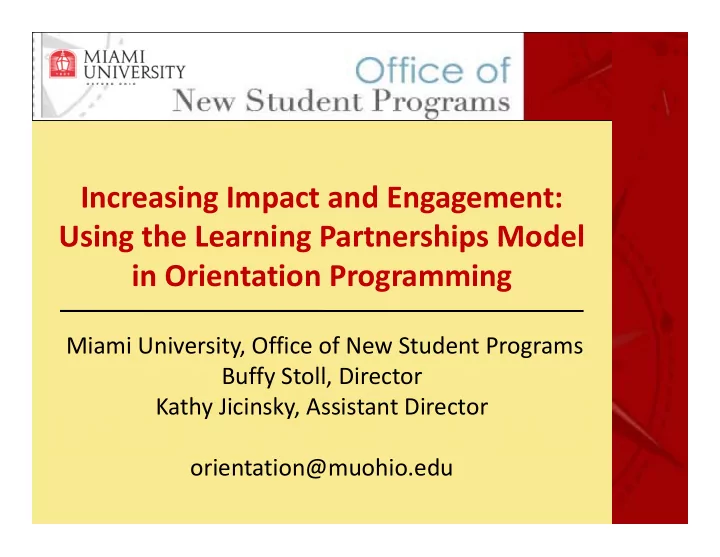

Increasing Impact and Engagement: Using the Learning Partnerships Model Using the Learning Partnerships Model in Orientation Programming Miami University, Office of New Student Programs Buffy Stoll, Director Buffy Stoll, Director Kathy Jicinsky, Assistant Director orientation@muohio.edu
Where we’re coming from Where we re coming from Functionally… • developed a framework for student outcomes made developmentally appropriate changes to program • utilized Learning Partnerships Model (Baxter Magolda, 2004) utilized Learning Partnerships Model (Baxter Magolda, 2004) • Contextually… • new to institution new to institution • attracted to engaged learning mission joined a division ready for change •
Creating Meaningful Experiences Creating Meaningful Experiences • What are some desired outcomes of your program? • What are some desired outcomes of your program? • What does success look like? • What competencies do you want your students to have as a result of attending Orientation?
What do students expect of Orientation? How do students’ expectations compare to our desired outcomes? t d i d t ?
Journey Toward Self ‐ Authorship L Leading Edge: di d Leading Edge: d d Leading Edge: Acting Recognizing that Evaluating multiple consistently based multiple perspectives to form on internal beliefs perspectives exist internal beliefs Stage Dependent on Beginning to Forming own others for others for question question sense of sense of lopmental Self- answers, values, authority, form values and Authored identity views, develop views to guide Life identity identity relationships relationships Devel and decisions Externally Focused >> Externally Focused >> Baxter Magolda, 1999. >> Internally Focused Taylor, 2009.
Our Framework: The 4 Cs Our Framework: The 4 Cs • Confident …ideas of autonomy • Comfortable …ideas of support • Connected …ideas of belonging • Curious …ideas of discovery • Purposeful framework set up our measurable goals
Our Goals New students will utilize written reflection as a means to recognize • differences between: their high school experience and their anticipated Miami experience – their expectations of Miami before Orientation, and how those expectations – are altered as a result of Orientation their own expectations and goals, and those of their parents’ and family their own expectations and goals, and those of their parents and family – members New students will be able to identify at least one campus resource • that they might utilize to support their success at Miami. New students will keep in touch (via email, facebook, etc.) with • one or more students whom they meet at Orientation. • New students will identify at least one exploratory question/topic y p y q / p to discuss with their academic advisor on Day 2.
Getting from here to there Getting from here to there • Developmental framework/goals don’t automatically translate into developmental programs l d l l • What formats/methods do our programs currently use? • What formats/methods do our programs currently use? • lecture style presentations • small group discussions with student leaders • group advising • skits • resource fair
The Learning Partnerships Model (LPM) g p ( ) Support • Validate learners’ capacity to know lid l ’ i k • Situate learning in learners’ experience • Define learning as mutually constructing meaning • Define learning as mutually constructing meaning Challenge • Portray knowledge as complex & socially constructed Portray knowledge as complex & socially constructed • Self is central to knowledge construction • Share authority & expertise in the learning process y p g p Baxter Magolda, 2004.
Incorporating the LPM p g • Written reflection solves the breadth vs. depth problem • Reflection activity gives structure to group discussions • Reflection activity gives structure to group discussions • Goal ‐ setting prompts feelings of control & connection • Individual advising humanizes a process that students Individual advising humanizes a process that students typically understand as mechanical
Impact and Inspiration p p Results • Faculty, staff, advisors WANT to see me l ff d i • College is different from high school • Miami isn’t what I expected • Miami isn t what I expected Future plans • Thinking about families • considering clickers • seeking seamlessness ki l
References References Baxter Magolda, M.B. (1999). Creating contexts for learning and self ‐ authorship: constructive ‐ developmental pedagogy (1 st ed.). Nashville, TN: Vanderbilt University Press. Baxter Magolda, M.B. (2004). Learning Partnerships Model: A framework for promoting self ‐ authorship. In M.B. Baxter Magolda & P.M. King (Eds.), Learning partnerships: Theory & models of practice to educate for self ‐ authorship (pp. 37 ‐ 62) . Sterling, VA: Theory & models of practice to educate for self authorship (pp. 37 62) . Sterling, VA: Stylus. Taylor, K.B. (2009). Miami University b icentennial symposium on the engaged university: Final plenary session [Powerpoint slides]. Retrieved from http://engageduniversity wordpress com/final ‐ plenary ‐ session/ http://engageduniversity.wordpress.com/final ‐ plenary ‐ session/
Recommend
More recommend